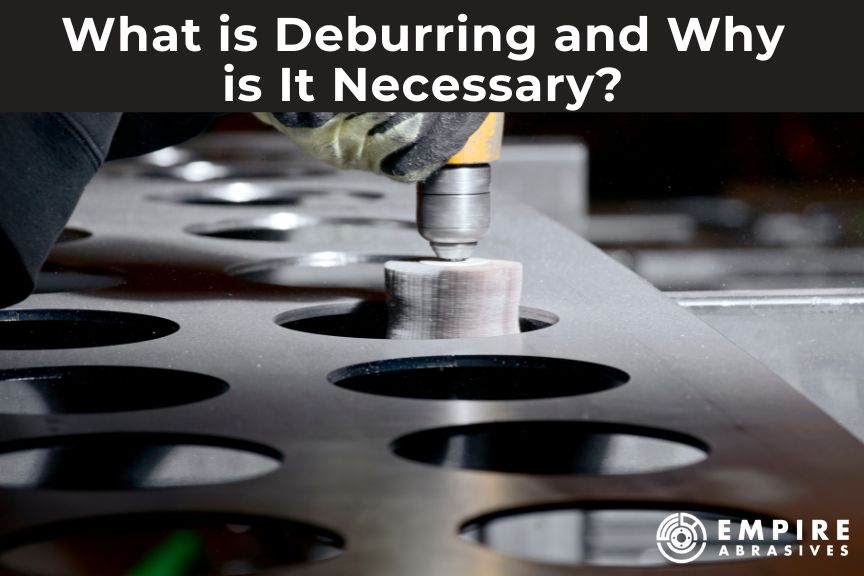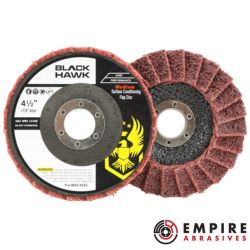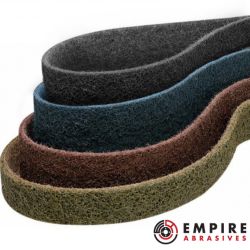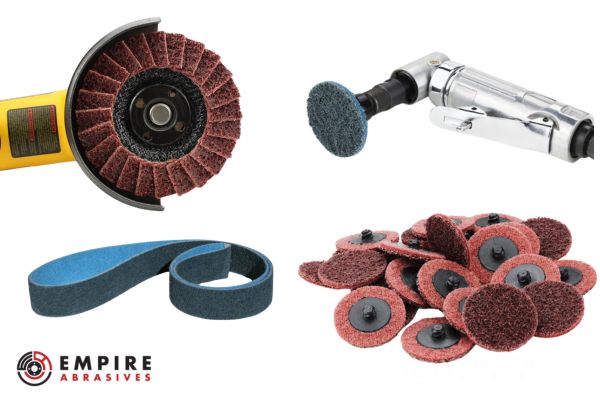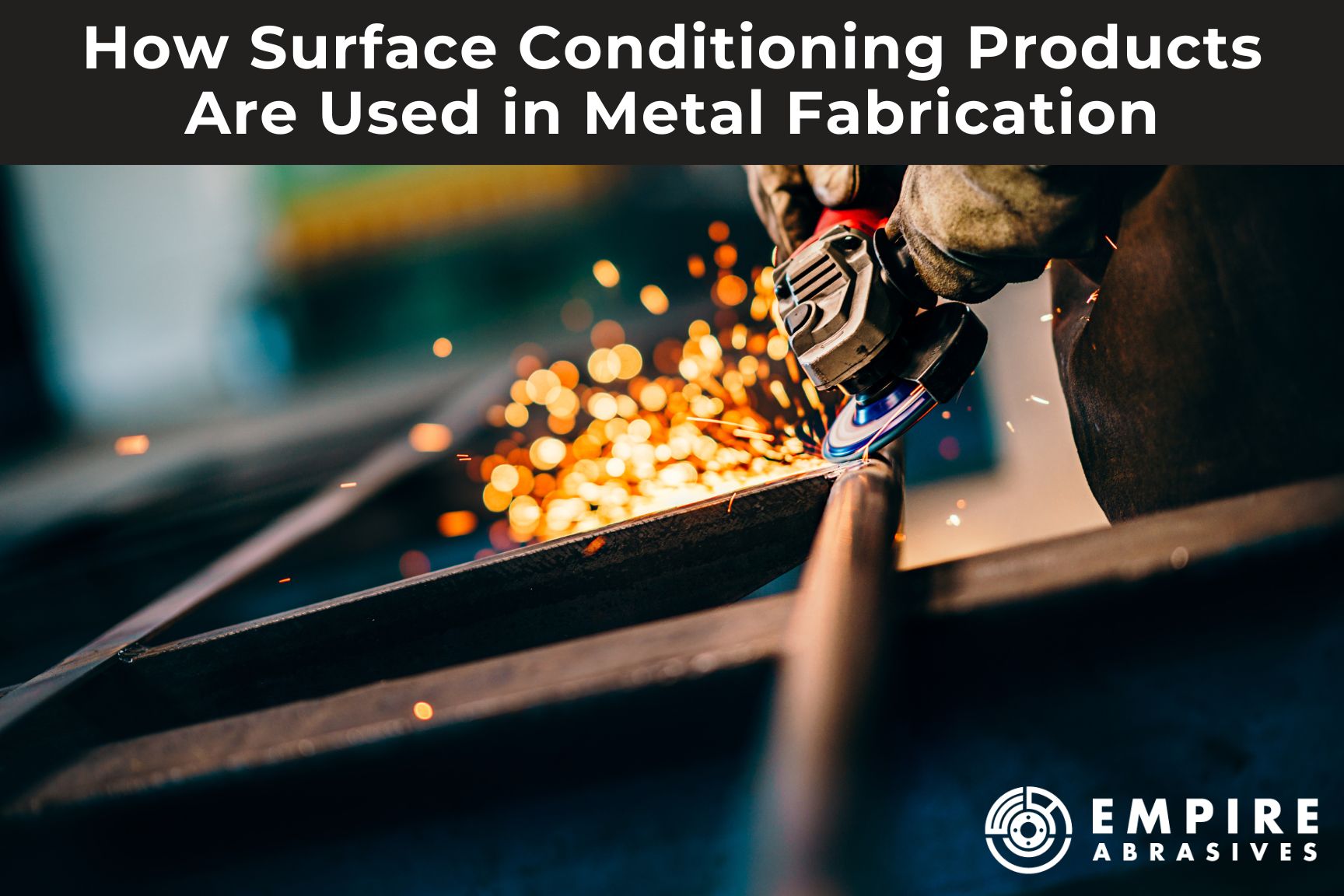
Metal fabrication turns raw metal materials into functional components and finished products. Surface conditioning is an important part of this process that helps fabricators enhance the aesthetics, durability, and performance of the fabricated parts. It involves preparing, blending, deburring, and finishing metal surfaces. This post goes over what surface conditioning products are, the different types available, and recommendations for the best ones to use for different metal fab applications.
What Are Surface Conditioning Products?
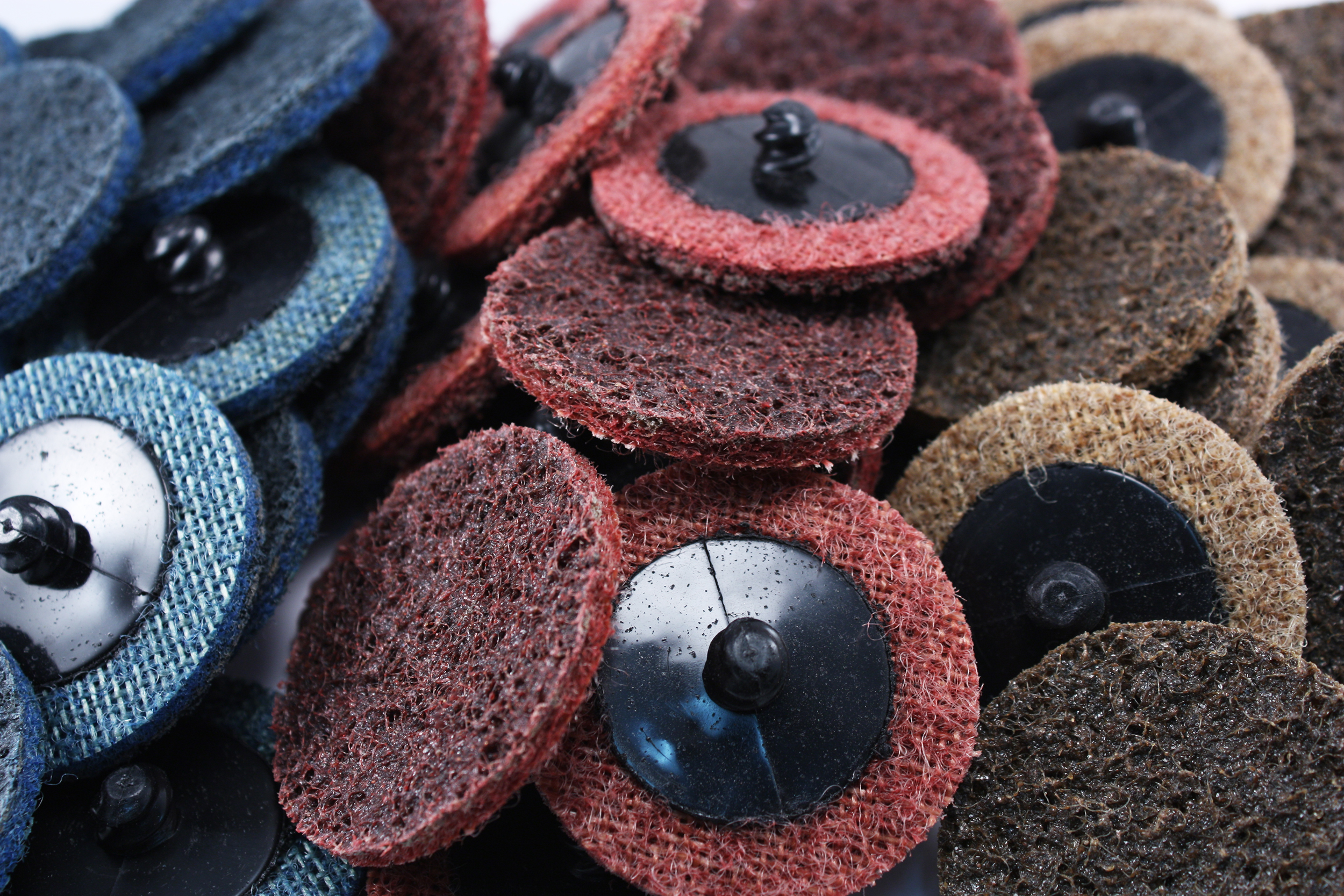 Surface conditioning products, sometimes referred to by the trademarked name Scotch-Brite™, are
specialized abrasives made from non-woven nylon fibers impregnated with
abrasive grains like aluminum oxide, zirconia, or ceramic. Unlike traditional
coated abrasives,
surface conditioning (Scotch-Brite™) pads, wheels, or belts offer a more controlled and consistent finish without
significantly altering the dimensions of the workpiece.
Surface conditioning products, sometimes referred to by the trademarked name Scotch-Brite™, are
specialized abrasives made from non-woven nylon fibers impregnated with
abrasive grains like aluminum oxide, zirconia, or ceramic. Unlike traditional
coated abrasives,
surface conditioning (Scotch-Brite™) pads, wheels, or belts offer a more controlled and consistent finish without
significantly altering the dimensions of the workpiece.
Characteristics:
- Non-Woven Structure: Provides flexibility to conform to complex shapes and contours.
- Open Web Design: Reduces heat buildup and resists loading.
Benefits of Surface Conditioning in Metal Fabrication
Using surface conditioning products for metal fabrication processes has several advantages:
Controlled Material Removal : They remove surface imperfections without removing much of the underlying material or altering the dimensions of the workpiece.
Improved Surface Quality : These products produce consistent finishes across multiple parts. They also prepare surfaces for subsequent processes like coating, painting, or plating.
Versatility: They can be used on most metals and are also suitable for a wide range of uses, from heavy-duty deburring to fine finishing tasks.
Reduced Heat Generation : The open web design helps dissipate heat which vastly minimizes the chances of warping or discoloration of the metal.
The Role of Surface Conditioning in Metal Fabrication
Surface conditioning bridges the gap between surface preparation (cleaning and removing contaminants) and surface finishing (applying coatings or polishing to a final finish). Here's how surface conditioning products are utilized:
1. Deburring
After cutting or machining, metal parts often have burrs or sharp edges that need to be removed for safety and functionality.
- Edge Refinement: Surface conditioning belts or discs smooth out rough edges without rounding or distorting the part.
- Safety Enhancement: Sharp edges that can cause injuries are eliminated.
- Functional Improvement: Ensures proper fitting of parts and reduces stress concentrations that could lead to failure.
Example: A fabricator uses a 2"x72" surface conditioning belt to deburr laser-cut steel components to make them safe enough to handle and fit accurately during assembly.
2. Blending
Welding and other joining processes can leave behind seams or uneven surfaces.
- Seam Smoothing: Surface conditioning discs blend weld beads into the surrounding metal for a seamless appearance.
- Surface Uniformity: Creates a consistent texture across the entire workpiece to enhance its aesthetics and function.
- Preparation for Finishing: Provides an ideal surface for painting or coating by eliminating surface irregularities.
Example: After MIG welding aluminum panels, surface conditioning flap discs can be used to blend the welds, preparing the panels for anodizing.
3. Cleaning
Surface conditioning products can remove light contaminants without aggressive material removal.
- Oxide and Rust Removal: Cleans off surface oxidation that can affect welding or coating adhesion.
- Discoloration Elimination: Removes heat tint and discoloration from processes like welding or heat treating.
- Gentle Action: Cleans the metal surface without scratching or damaging the base material.
Example: A stainless steel fabricator uses surface conditioning hand pads to clean and brighten a surface before passivation.
4. Finishing
Achieving the desired surface texture is essential for the final appearance and performance.
- Surface Texturing: Creates specific finishes, from matte to satin.
- Preparation for Polishing: Refines the surface to a uniform scratch pattern, making subsequent polishing more efficient.
- Aesthetic Enhancement: Improves the visual appeal of consumer products, architectural elements, and more.
Example: A series of surface conditioning belts with progressively finer grits is used to achieve a brushed finish on a metal railing.
Types of Surface Conditioning Products and How They’re Used
| Product Type | Applications | Benefits | Common Uses | Compatible Tools | Expert Tips |
|---|---|---|---|---|---|
| Non-Woven Surface Conditioning Belts | General surface conditioning, blending, light deburring. Often used to prepare stainless steel and aluminum for finishing | Minimal heat buildup, flexibility, available in various grits for different levels of aggressiveness | Deburring large flat areas, blending seams on stainless steel | Belt Sanders, Linishing Machines | Use light pressure to avoid excessive material removal |
| Non-Woven Surface Conditioning Flap Discs | Smoothing welds, blending edges, finishing tasks on flat or contoured surfaces |
Shaped like a flap disc that benefits you with a longer product life and more consistent finishes |
Blending welds on visible parts, finishing aluminum panels | Angle Grinders | Keep the disc moving to avoid heat buildup |
| Non-Woven Hand Pads | Detail work, rust removal, surface prep in tight spaces | Lightweight and flexible, ideal for manual precision work | Cleaning intricate components, light rust removal | Handheld | Keep a variety of grit levels on hand for versatility |
| Surface Conditioning Hook and Loop Discs | Achieving brushed or satin finishes on flat surfaces | Easy grit-level changes, efficient for multi-step finishing | Satin finishing of stainless steel sheets | Angle Grinders, Orbital Sanders | Switch grits easily for efficient step-by-step finishing |
| Surface Preparation Wheels | Deburring, cleaning, polishing | Long-lasting, controlled finishes, suitable for hand-held or automated uses | Pre-weld cleaning, removing contaminants | Bench Grinders, Die Grinders | Apply steady pressure for uniform cleaning |
| Interleaf Mounted Flap Wheels | Precision finishing in small areas such as internal pipe surfaces | Aggressive cutting and fine finishing in one tool | Finishing the interior of tubes or pipes | Die Grinders | Alternate between aggressive and fine passes for best results |
| Interleaf Flap Wheel Drums | Used on curved surfaces like pipes and tubes for uniform finishes | Combines deburring and finishing in one tool | Brushed finishes on cylindrical surfaces | Drum Sanders, Eastwood SCT Surface Conditioning Tool, Linear Grinder | Use a steady, consistent speed to maintain uniformity |
| Satin Surface Prep Airway Buffs | Achieving satin finishes on stainless steel or aluminum | Minimal heat buildup ensures quality results during finishing | Final finishing of kitchen-grade stainless steel | Buffing Machines, Angle Grinders | Finish in the direction of the grain for best appearance |
| Quick Change Unitized Discs | Deburring, blending, light finishing, especially in tight spaces | Quick-change system for workflow efficiency | Finishing tight or intricate spaces, blending small welds | Die Grinders, Drills, Air Grinder | Use for rapid tool changes in high-volume environments |
Step-by-Step Guide to Using Surface Conditioning Products in Metal Fabrication
Stage 1: Initial Cleaning and Preparation
- Tools to Use: Surface Preparation Wheels, Non-Woven Hand Pads
- Usage: Remove rust, debris, or contamination before welding to ensure strong, clean welds. Example: Prepping a stainless-steel frame before assembly
- Pro Tip: Use light pressure to avoid damaging delicate surfaces during rust removal.
Stage 2: Blending and Smoothing Welds
- Tools to Use: Non-Woven Surface Conditioning Flap Discs, Interleaf Mounted Flap Wheels
- Usage: Smooth weld seams for a seamless appearance and prepare for further finishing. Example: Creating a smooth joint on a visible railing
- Pro Tip: Keep the tool moving steadily along the weld seam to avoid creating low spots or over-thinning the metal.
Stage 3: Edge Finishing and Deburring
- Tools to Use: Non-Woven Surface Conditioning Belts, Quick Change Unitized Discs
- Usage: Smooth out burrs after cutting or punching to create clean, safe edges. Example: Deburring punched holes in an aluminum sheet for an electrical enclosure.
- Common Mistake: Applying excessive pressure can lead to material removal beyond what’s needed. Let the tool do the work.
Stage 4: Final Finishing and Polishing
- Tools to Use: Surface Conditioning Hook and Loop Discs, Satin Surface Prep Airway Buffs
- Usage: Achieve the desired final finish, whether a satin polish or a reflective surface. Example: Polishing kitchen-grade stainless steel for aesthetics.
- Pro Tip: Always finish in the direction of the grain for a consistent appearance, especially on stainless steel.
Choosing the Right Surface Conditioning Product for Different Metals
- Stainless Steel: Opt for non-woven products to avoid heat discoloration and maintain surface integrity.
- Aluminum: Use products with minimal material removal to prevent gouging or melting. Lower pressure settings help maintain the soft surface.
- Mild Steel: Abrasive belts and flap wheels work well for heavier cutting and blending due to its resilience.
Tips for Extending Product Lifespan and Efficiency
- Speed Settings: Use the correct speed for each product. Even though they are better for heat dissipation than other abrasives, higher speeds may result in overheating and reduced lifespan. On the other hand, using speeds lower than the recommended range can lead to suboptimal performance and may cause the abrasive to wear unevenly.
- Pressure Control: Light to moderate pressure will extend the product’s life and prevent damage to the workpiece.
- Regular Maintenance: Clean abrasive tools after use to remove accumulated debris.
- Pro Tip: Regularly inspect for wear and replace abrasives before they become inefficient, which can cause damage or slow down workflow.
Conclusion
Surface conditioning products are critical in achieving professional results in metal fabrication. From deburring and blending to cleaning and finishing, these help ensure high-quality, durable, and aesthetically pleasing metalwork. Whether you're working on stainless steel, aluminum, or mild steel, choosing the right surface conditioning product can make all the difference. By integrating these products into your workflow, you can enhance efficiency and elevate the quality of your projects.
Explore our wide range of surface conditioning tools and abrasive products at Empire Abrasives. Whether you need belts, discs, or specialty products for your next project, we have the solutions to meet your needs. For bulk orders or expert guidance, contact our team abrasives experts today and take your fabrication to the next level!
Additional Resources
- Your Ultimate Guide to Surface Conditioning Discs
- Troubleshooting Common Abrasive Tool Issues - Surface Conditioning Discs
- The Best Abrasive Tools for Sanding Curved Surfaces
- Surface Prepping a Car for Painting: Tools, Tips & Techniques for Automotive Painting Prep
- 7 Ways Abrasives Enhance Welding & Fabrication Part 2 Weld Grinding Cleaning Buffing & Surface Prep
- Scuff Pads vs. Sandpaper
- Guides to Pollution Prevention: The Fabricated Metal Products Industry (EPA)

